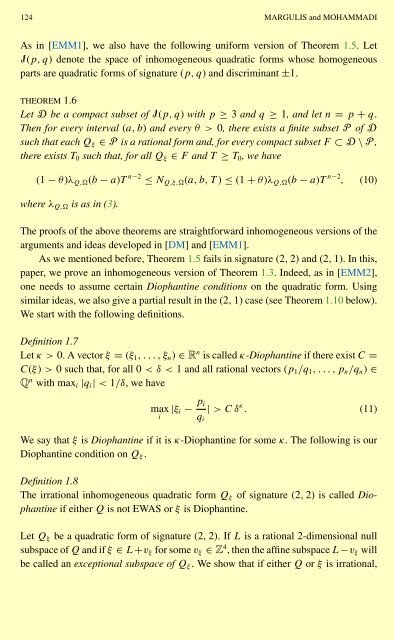NEAR OPTIMAL BOUNDS IN FREIMAN'S THEOREM
NEAR OPTIMAL BOUNDS IN FREIMAN'S THEOREM
NEAR OPTIMAL BOUNDS IN FREIMAN'S THEOREM
You also want an ePaper? Increase the reach of your titles
YUMPU automatically turns print PDFs into web optimized ePapers that Google loves.
124 MARGULIS and MOHAMMADI<br />
As in [EMM1], we also have the following uniform version of Theorem 1.5. Let<br />
I(p, q) denote the space of inhomogeneous quadratic forms whose homogeneous<br />
parts are quadratic forms of signature (p, q) and discriminant ±1.<br />
<strong>THEOREM</strong> 1.6<br />
Let D be a compact subset of I(p, q) with p ≥ 3 and q ≥ 1, and let n = p + q.<br />
Then for every interval (a,b) and every θ>0, there exists a finite subset P of D<br />
such that each Qξ ∈ P is a rational form and, for every compact subset F ⊂ D \ P ,<br />
there exists T0 such that, for all Qξ ∈ F and T ≥ T0, we have<br />
(1 − θ)λQ,(b − a)T n−2 ≤ NQ,ξ,(a,b,T ) ≤ (1 + θ)λQ,(b − a)T n−2 , (10)<br />
where λQ, is as in (3).<br />
The proofs of the above theorems are straightforward inhomogeneous versions of the<br />
arguments and ideas developed in [DM] and[EMM1].<br />
As we mentioned before, Theorem 1.5 fails in signature (2, 2) and (2, 1). In this,<br />
paper, we prove an inhomogeneous version of Theorem 1.3. Indeed,asin[EMM2],<br />
one needs to assume certain Diophantine conditions on the quadratic form. Using<br />
similar ideas, we also give a partial result in the (2, 1) case (see Theorem 1.10 below).<br />
We start with the following definitions.<br />
Definition 1.7<br />
Let κ>0. A vector ξ = (ξ1,...,ξn) ∈ R n is called κ-Diophantine if there exist C =<br />
C(ξ) > 0 such that, for all 0

















